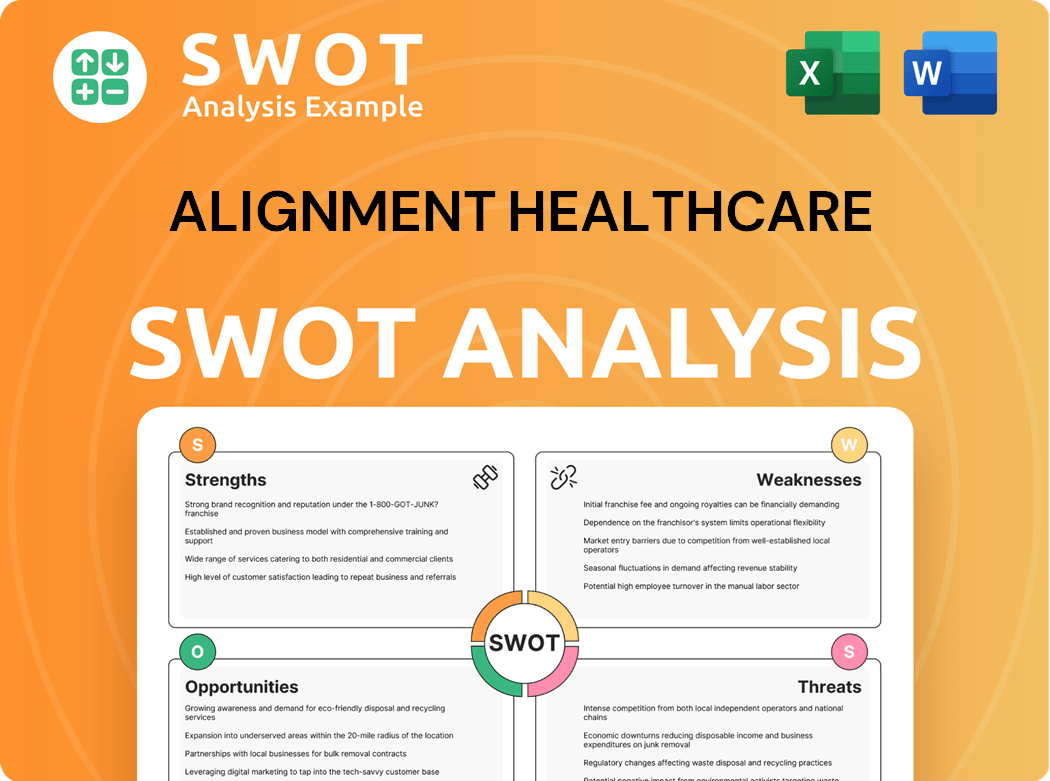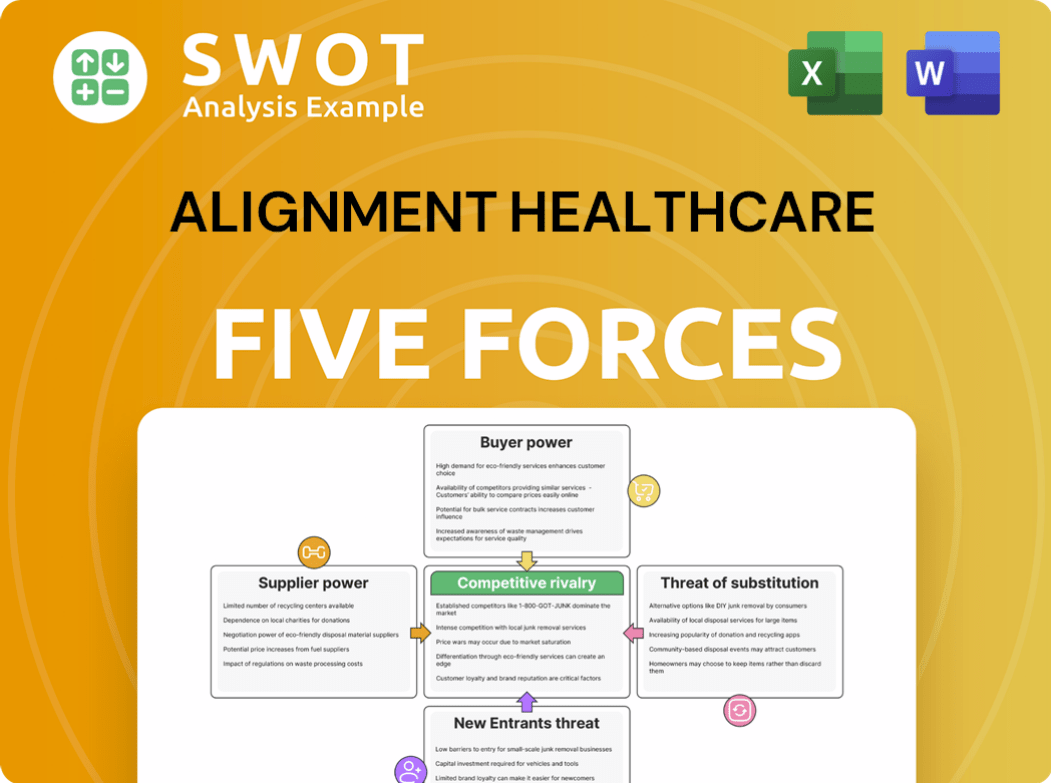Alignment Healthcare Bundle
Can Alignment Healthcare Continue Its Impressive Growth Trajectory?
Alignment Healthcare, a prominent player in the Medicare Advantage market, has captured significant attention with its impressive growth, boasting a 35% year-over-year increase in membership. This remarkable expansion underscores the critical importance of its Alignment Healthcare SWOT Analysis and overall growth strategy. Founded on a vision of personalized, high-tech, and high-touch care, the company is reshaping how seniors experience healthcare.

With over 200,000 members, Alignment Healthcare's strategic planning focuses on care management, aiming to enhance both quality and cost control in the competitive healthcare market. Understanding Alignment Healthcare's future prospects requires a deep dive into its expansion plans and strategies, examining how the company intends to navigate challenges and capitalize on opportunities for continued growth. This analysis will explore the company's financial performance review and its innovative approach to value-based care, offering insights into its long-term strategic goals.
How Is Alignment Healthcare Expanding Its Reach?
The company's growth strategy is heavily focused on expanding its reach within the healthcare market. A key component of this strategy involves increasing its membership base, which directly impacts its company performance. This expansion is carefully planned and executed, with a strong emphasis on providing quality care and services to its members.
Alignment Healthcare is strategically positioning itself for future growth by focusing on key areas and initiatives. This includes expanding its presence in existing markets, enhancing its product offerings, and forming strategic partnerships to improve access to care. These efforts are designed to drive sustainable growth and solidify its position in the competitive healthcare landscape.
Understanding the future prospects of the company requires a close look at its expansion initiatives and strategic direction. The company's ability to successfully execute its plans will be crucial in determining its long-term success and its ability to compete effectively in the healthcare industry. The company's efforts are crucial for its strategic planning.
Alignment Healthcare is actively growing its membership base. As of January 1, 2025, the company had approximately 209,900 members, reflecting a 35% year-over-year increase. The company anticipates further growth, projecting between 225,000 and 231,000 health plan members by the end of 2025.
While not entering new states in 2025, the company is focusing on expansion within existing markets. This includes significant growth in California, where it saw 28% membership growth and has over 10,000 members in some markets. The company is also expanding its presence in Nevada and Arizona through strategic partnerships.
The company is expanding its product offerings to meet the diverse needs of seniors. For 2025, it is offering 18 chronic condition and dual-eligible Special Needs Plans (SNPs), a 29% increase from 14 in 2024. These plans include benefits like monthly allowances for groceries and utilities.
Strategic partnerships are key to the company's expansion. In Nevada, a new agreement with Intermountain Health, effective January 1, 2025, expands access to over 65 clinic locations. In Arizona, an enhanced agreement with Arizona Priority Care provides access to a network of over 4,500 providers.
The company's expansion strategy focuses on increasing membership, expanding within existing markets, and enhancing product offerings. These initiatives are designed to drive growth and improve the company's position in the healthcare market. The company's focus is on providing value-based care.
- Membership growth through strong enrollment.
- Expansion within existing markets like California, Nevada, and Arizona.
- Increased product offerings, including chronic condition and dual-eligible SNPs.
- Strategic partnerships to expand access to care.
For a deeper understanding of the competitive landscape, including the company's position relative to its competitors, consider reading more about the Competitors Landscape of Alignment Healthcare.
Alignment Healthcare SWOT Analysis
- Complete SWOT Breakdown
- Fully Customizable
- Editable in Excel & Word
- Professional Formatting
- Investor-Ready Format

How Does Alignment Healthcare Invest in Innovation?
The company's growth strategy heavily relies on leveraging technology and innovation to improve healthcare delivery. A core component of this strategy is its proprietary platform, AVA®, which uses artificial intelligence to provide personalized insights. This approach aims to enhance care quality and reduce costs, driving the company's overall performance.
By focusing on technology, the company aims to better integrate front-line care with digital and clinical insights. This strategy strengthens the company's ability to provide compassionate, high-quality care. This focus on innovation is a key factor in the company's future prospects within the competitive healthcare market.
The company's commitment to innovation is further demonstrated by the promotion of Dr. Arta Bakshandeh to President of AVA. This move signifies a focus on advancing responsible AI and improving member experience through the platform.
AVA® is an AI-enabled Medicare Advantage platform. It utilizes over 200 data sources and 13,000 attributes to generate personalized insights. This platform aims to provide real-time visibility to stakeholders to improve care quality and reduce costs.
The company focuses on integrating data-driven solutions throughout the member journey. This approach is designed to enhance the delivery of care. The strategic planning involves leveraging data to improve patient outcomes.
In 2023, AVA incorporated clinician input to improve care delivery. This collaborative approach ensures that the platform aligns with the needs of healthcare providers. This integration is crucial for the company's growth strategy.
The platform has improved administrative efficiency. In 2023, the platform reduced administrative processing time per member by approximately 45 minutes. This improvement contributes to cost savings.
AVA has seen substantial growth in external users. In 2023, the platform added over 10,000 new external users. This expansion reflects the platform's increasing adoption and value within the healthcare market.
The company is committed to advancing responsible AI. The promotion of Dr. Arta Bakshandeh to President of AVA underscores this commitment. This strategic move aims to enhance member experience.
The company's growth strategy leverages technology to improve healthcare outcomes and manage medical expenses. The AVA platform is central to these efforts, providing personalized insights and streamlining administrative processes. This focus on innovation is a key element of their strategic planning.
- AVA Platform Expansion: The company is focused on scaling the AVA platform. This includes integrating data-driven solutions throughout the member journey.
- Clinician Collaboration: The company incorporates clinician input to improve care delivery. This collaborative approach ensures that the platform meets the needs of healthcare providers.
- Administrative Efficiency: The AVA platform reduces administrative processing time. This improves operational efficiency and contributes to cost savings.
- Responsible AI: The company is committed to advancing responsible AI. This commitment is reflected in leadership appointments and strategic initiatives.
Alignment Healthcare PESTLE Analysis
- Covers All 6 PESTLE Categories
- No Research Needed – Save Hours of Work
- Built by Experts, Trusted by Consultants
- Instant Download, Ready to Use
- 100% Editable, Fully Customizable

What Is Alignment Healthcare’s Growth Forecast?
The financial outlook for Alignment Healthcare in 2025 points towards continued growth, with a strong emphasis on profitability. The company's strategic planning focuses on disciplined bidding and margin expansion, aiming to improve its financial performance in the competitive healthcare market. This approach is designed to balance growth with sustainable financial results.
In 2024, the company achieved its first full year of positive adjusted EBITDA as a public entity, demonstrating a significant milestone in its journey. This achievement sets a positive foundation for future growth and profitability. The company is strategically positioned to leverage its strengths and capitalize on opportunities within the healthcare market.
The company's revenue guidance for 2025 is set between $3.72 billion and $3.78 billion, reflecting a substantial year-over-year growth of 37.6%-39.6%. This growth is driven by factors such as membership expansion and strategic initiatives. The company's ability to achieve these revenue targets will be critical for its overall financial performance and future prospects.
The projected revenue for 2025 is between $3.72 billion and $3.78 billion, indicating substantial growth.
Adjusted EBITDA is projected to be between $35 million and $60 million for 2025.
The company anticipates adjusted gross profit to be between $415 million and $445 million in 2025.
The company expects health plan membership to reach between 225,000 and 231,000 by the end of 2025.
Membership growth is a key driver of the company's financial outlook. As of January 1, 2025, membership was approximately 209,900, reflecting a 35% increase year-over-year. The company's Q1 2025 results showed revenue of $926.9 million, a 47.5% year-over-year increase, and a membership of 217,500, up 31.7%. The adjusted EBITDA for Q1 2025 was positive at $20.2 million, a significant improvement from a loss in Q1 2024. The company is aiming for at least a 20% growth in Medicare Advantage membership.
The company's financial strategy includes disciplined bidding to balance growth and profitability.
Margin expansion is expected, driven by improvements in the medical benefits ratio and operational efficiencies.
The company had a net loss of $128.1 million for the full year 2024, but the adjusted EBITDA turned positive.
Management anticipates at least a 20% growth in Medicare Advantage membership.
Q1 2025 showed strong performance with revenue of $926.9 million and positive adjusted EBITDA of $20.2 million.
The long-term strategic goals include sustainable growth and enhanced profitability within the healthcare market.
Alignment Healthcare Business Model Canvas
- Complete 9-Block Business Model Canvas
- Effortlessly Communicate Your Business Strategy
- Investor-Ready BMC Format
- 100% Editable and Customizable
- Clear and Structured Layout

What Risks Could Slow Alignment Healthcare’s Growth?
The healthcare market is highly competitive, and the company faces several potential risks that could influence its Mission, Vision & Core Values of Alignment Healthcare and future prospects. These challenges include market competition, regulatory changes, and operational hurdles. Successfully navigating these obstacles is crucial for achieving its growth strategy and maintaining a strong position in the industry.
Regulatory changes, especially those related to Medicare Advantage funding and risk adjustment, pose significant challenges. The company's ability to maintain high star ratings is critical, as these ratings impact consumer choice and reimbursement rates from CMS. Any decline in star ratings could negatively affect its ability to attract and retain members, as well as its revenue.
Operational challenges, such as attracting new members and entering new markets, also present risks. Maintaining relationships with care providers and managing labor costs are essential for success. The company's reliance on forward-looking statements introduces additional uncertainties that could affect actual results. It must also balance growth with profitability and effectively manage medical costs.
The healthcare market is intensely competitive. Other companies are also pursuing high ratings and market share. This competition puts pressure on the company to differentiate itself and retain its market position. The competitive landscape requires continuous adaptation and innovation to thrive.
Changes in healthcare regulations, including potential cuts in Medicare Advantage funding, pose significant risks. Changes in risk adjustment regulations can also impact revenue. Navigating these regulatory shifts requires strategic planning and adaptability to ensure compliance and financial stability.
The inability to reconcile adjusted gross profit and adjusted EBITDA to GAAP measures creates uncertainty. This lack of clarity may raise concerns about financial transparency. Investors and stakeholders depend on clear and consistent financial reporting to assess company performance and make informed decisions.
Maintaining high ratings on the Five Star Quality Rating System is crucial. These ratings influence consumer choices and CMS reimbursement rates. A decline in star ratings for a key plan could negatively impact member attraction and revenue. High ratings are essential for sustaining a competitive advantage.
Being a government contractor introduces specific risks related to changes in laws and regulations. Changes in government policies can directly impact the company's business model and profitability. It is essential to monitor and adapt to policy changes to mitigate these risks.
Attracting new members and entering new markets requires governmental approvals. Maintaining relationships with care providers is also essential. Shortages of qualified personnel and rising labor costs can create obstacles. Successful operations depend on overcoming these challenges.
The company's reliance on forward-looking statements introduces risks that could materially affect actual results. These statements are based on current expectations and assumptions, which may not materialize. Investors should consider these risks when evaluating the company's future prospects.
Balancing growth with profitability and effectively managing medical costs is crucial. A slightly higher-than-anticipated medical loss ratio in the past indicates the need for careful cost management. Efficiently managing medical expenses directly impacts the company's financial performance and sustainability.
Risks related to indebtedness, including the potential for rising interest rates, are also factors to consider. Higher interest rates can increase borrowing costs, affecting profitability. Managing debt levels and interest rate exposure is crucial for financial stability and Alignment Healthcare's long-term success.
Successful execution of the growth strategy depends on overcoming these challenges. The company must navigate the complexities of the healthcare market, adapt to regulatory changes, and maintain operational efficiency. Effective strategic planning and execution are critical for achieving its goals.
Alignment Healthcare Porter's Five Forces Analysis
- Covers All 5 Competitive Forces in Detail
- Structured for Consultants, Students, and Founders
- 100% Editable in Microsoft Word & Excel
- Instant Digital Download – Use Immediately
- Compatible with Mac & PC – Fully Unlocked

Related Blogs
- What are Mission Vision & Core Values of Alignment Healthcare Company?
- What is Competitive Landscape of Alignment Healthcare Company?
- How Does Alignment Healthcare Company Work?
- What is Sales and Marketing Strategy of Alignment Healthcare Company?
- What is Brief History of Alignment Healthcare Company?
- Who Owns Alignment Healthcare Company?
- What is Customer Demographics and Target Market of Alignment Healthcare Company?
Disclaimer
All information, articles, and product details provided on this website are for general informational and educational purposes only. We do not claim any ownership over, nor do we intend to infringe upon, any trademarks, copyrights, logos, brand names, or other intellectual property mentioned or depicted on this site. Such intellectual property remains the property of its respective owners, and any references here are made solely for identification or informational purposes, without implying any affiliation, endorsement, or partnership.
We make no representations or warranties, express or implied, regarding the accuracy, completeness, or suitability of any content or products presented. Nothing on this website should be construed as legal, tax, investment, financial, medical, or other professional advice. In addition, no part of this site—including articles or product references—constitutes a solicitation, recommendation, endorsement, advertisement, or offer to buy or sell any securities, franchises, or other financial instruments, particularly in jurisdictions where such activity would be unlawful.
All content is of a general nature and may not address the specific circumstances of any individual or entity. It is not a substitute for professional advice or services. Any actions you take based on the information provided here are strictly at your own risk. You accept full responsibility for any decisions or outcomes arising from your use of this website and agree to release us from any liability in connection with your use of, or reliance upon, the content or products found herein.